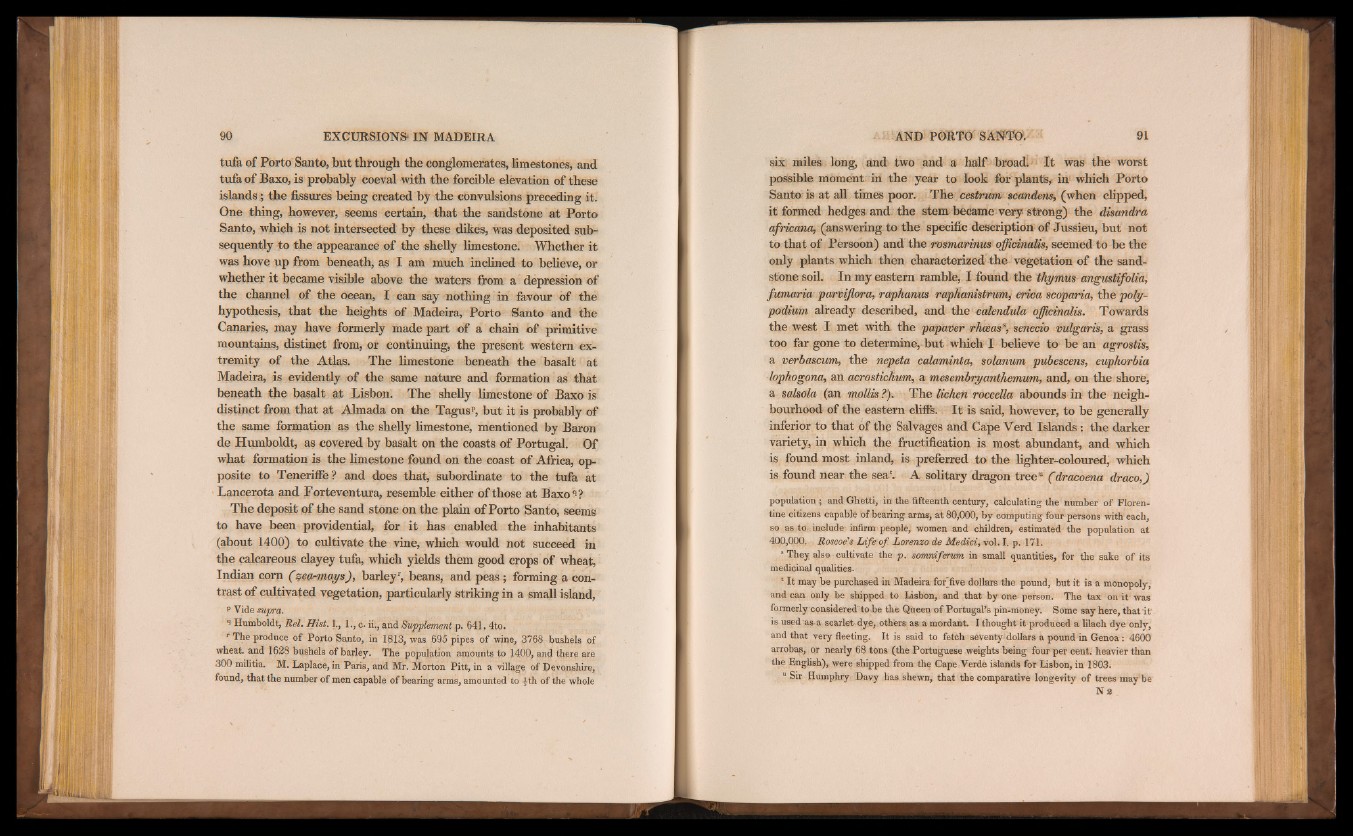
tufa of Porto Santo, but through the conglomerates, limestones, and
tufa of Baxo, is probably coeval with the forcible elevation of these
islands; the fissures being created by the convulsions preceding it.
One thing, however, seems certain, that the sandstone at Porto
Santo, which is not intersected by these dikes, was deposited subsequently
to the appearance of the shelly limestone. Whether it
was hove up from beneath, a.s I am much inclined to believe, or
whether it became visible above the waters from a depression of
the channel of the ocean, I can say nothing in favour of the
hypothesis, that the heights of Madeira, Porto Santo and the
Canaries, may have formerly made part of a chain of primitive
mountains, distinct from, or continuing, the present western extremity
of the Atlas. The limestone beneath the basalt at
Madeira, is evidently of the same nature and formation as that
beneath the basalt at Lisbon. The shefiy limestone of Baxo is
distinct from that at Almada on the Tagus p, but it is probably of
the same formation as the shelly limestone, mentioned by Baron
de Humboldt, as covered by basalt on the coasts of Portugal. Of
what formation is the limestone found on the coast of Africa, opposite
to Teneriffe? and does that, subordinate to the tufa at
Lancerota and Forteventura, resemble either of those at Baxo«?
The deposit of the sand stone on the plain of Porto Santo, seems
to have been providential, for it has enabled the inhabitants
(about 1400) to cultivate the vine, which would not succeed m
the calcareous clayey tufa, which yields them good crops of wheat,
Indian corn (%egwnays), barley', beans, and peas ; forming a contrast
of cultivated vegetation, particularly striking in a small island,
p Vide supra.
’ Humboldt, Rel. Hist. 1., 1., c. ii., and Supplement p. 641,4to.
r The produce of Porto Santo, in 1813, was 695 pipes of wine, 3768 bushels of
wheat, and 1628 bushels of barley. The population amounts to 1400, and there are
300 militia. M. Laplace, in Paris, and Mr. Morton Pitt, in a village of Devonshire,
found, that the number of men capable of bearing arms, amounted to 4th of the whole
six miles long, and two and a half broad, i It was the worst
possible moment, in the year to look for plants, in which Porto
Santo is at all times poor. The cestrum scandens, (when clipped,
it formed hedges, and. the stem became very strong) the disandra
africana, (answering to the specific description of Jussieu, but not
to that of Persoon) and the rosmarinus officinalis, seemed to be the
only plants which then characterized the vegetation of the sandstone
soil. In my eastern ramble, I found the thymus angustifolia,
fumaria parviflora, raphanus raphanistrwm, erica scoparia, the polypodium
already described, and the calendula officinalis. Towards
the west I met with the papaver rhceas*, senecio vulgaris, a grass
too far gone to determine, but which I believe to be an agrostis,
a perbascum, the nepeta calaminta, solatium pubescens, euphorbia
lophogona, an acrostichum, a mesembryanthemum, and, on the shore,
a salsola (an mollis ?). The lichen roccella abounds in the neighbourhood
of the eastern cliffs. It is said, however, to be generally
inferior to that of the Salvages and Cape Verd Islands: the darker
variety, in which the fructification is most abundant, and which
is found most inland, is preferred to the lighter-coloured, which
is found near the sea'. A solitary dragon tree" ( dracoena draco,)
population ; and Ghetti, in the fifteenth century, Calculating the number of Florentine
citizens capable of bearing arms, at 80,000, by computing four persons with each,
so as to include infirm people, women and children, estimated the population at
400,000. Roscods Life of Lorenzo de Medici, vol. I. p. 171.
| They also cultivate the p. somniferum in small quantities, for the sake of its
medicinal qualities.
' It may be purchased in Madeira for’five dollars the pound, but it is a monopoly,
and can only be shipped to Lisbon, and that by one person. The tax on it was
formerly considered~to.be the Queen of Portugal’s pin-money. Some say here, that it
is used as a scarlet- dye, others as a mordant. I thought it produced a lilach dye only,
and that very fleeting. It is said to fetch seventy dollars a pound in Genoa: 4600
arrobas, or nearly 68 tons (the Portuguese weights being four per cent, heavier than
the English), were shipped from the Cape Verde islands for Lisbon, in 1803.
u Sir Humphry Davy has shewn, that the comparative longevity of trees may be